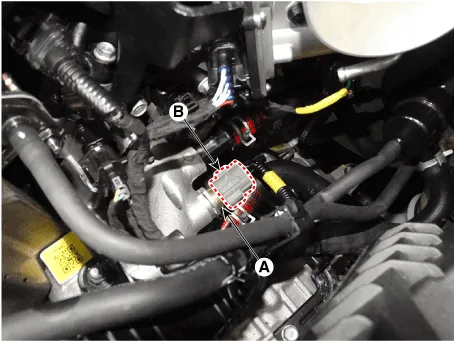Hyundai Palisade (LX2): Engine Control System / Engine Coolant Temperature Sensor (ECTS)
Description and operation
Located in the engine coolant passage of the cylinder head, Engine Coolant Temperature
Sensor (ECTS) detects the engine coolant temperature. The ECTS uses a thermistor
with resistance in proportion to the temperature.
The electrical resistance of the ECTS decreases as the temperature increases,
and increases as the temperature decreases. The reference +5V is supplied to
the ECTS via a resistor in the ECM. That is, the resistor in the ECM and the
thermistor in the ECTS are connected in series. When the resistance value of
the thermistor in the ECTS changes according to the engine coolant temperature,
the output voltage also changes.ion duration and controls the ignition timing
using the information of engine coolant temperature to avoid engine stalling
and improve drivability.
During cold engine operation, the ECM increases the frequency of fuel injection
and controls the ignition timing using the information of engine coolant temperature
to avoid engine stalling and improve drivability.

Specifications
Temperature
|
Resistance (kΩ)
|
°C
|
°F
|
-40
|
-40
|
48.14
|
-20
|
-4
|
14.13 - 16.83
|
0
|
32
|
5.79
|
20
|
68
|
2.31 - 2.59
|
40
|
104
|
1.15
|
60
|
140
|
0.59
|
80
|
176
|
0.32
|
Schematic diagrams

Harness Connector

Repair procedures
| 1. |
Switch "OFF" the ignition.
|
| 2. |
Disconnect the ECTS connector.
|
| 3. |
Remove the ECTS.
(Refer to "Removal")
|
| 4. |
After immersing the thermistor of the sensor into engine coolant, measure
resistance between the ECTS terminals 3 and 4.
|
| 5. |
Check that the resistance is within the specification.
Temperature
|
Resistance (kΩ)
|
°C
|
°F
|
-40
|
-40
|
48.14
|
-20
|
-4
|
14.13 - 16.83
|
0
|
32
|
5.79
|
20
|
68
|
2.31 - 2.59
|
40
|
104
|
1.15
|
60
|
140
|
0.59
|
80
|
176
|
0.32
|
|
| 1. |
Switch "OFF" the ignition and disconnect the negative (-) battery terminal.
|
| 2. |
Remove the air cleaner assembly.
(Refer to Engine Mechanical System - "Air Cleaner")
|
| 3. |
Disconnect the engine coolant temperature sensor connector (A).
|
| 4. |
Remove the water temperature sensor (B) from the water temperature control
assembly.
| •
|
Note that engine coolant may leak out of the water temperature
control assembly when removing the sensor.
|
|

|
| • |
Install the component to the specified torque.
|
| • |
Note that internal damage may occur if the component is dropped.
In this case, inspect the component before installation.
|
| • |
Insert the sensor in the installation hole and be careful not
to damage it during installation.
|
|
| 1. |
Install in the reverse order of removal.
|
| 2. |
Replenish the engine coolant.
(Refer to Engine Mechanical System - "Coolant System")
|
Description and operation
Description
Manifold Absolute Pressure Sensor (MAPS) is a speed-density type sensor installed
on the surge tank.
Description and operation
Description
Crankshaft Position Sensor (CKPS) detects the crankshaft position and is one
of the most important sensors of the engine control system.
Other information:
Description and operation
Description
The A/C Pressure Transducer (APT) converts the pressure value of high pressure
line into voltage value after measuring it. By converted voltage value, engine
ECU controls the cooling fan by operating it high speed or low speed.
Repair procedures
Inspection
1.
Turn the ignition switch ON.
2.
Manually operate the control switch and measure the voltage of the blower
motor.
3.
Select the control switch to raise the voltage until high speed.






